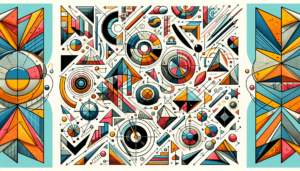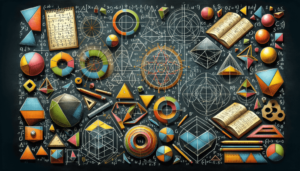If you’ve ever found yourself scratching your head when it comes to shapes, angles, and lines, then Geometry 101 is just what you need. This article is filled to the brim with all the information you need to make sense of the world of geometry. From basic concepts to more advanced topics like quadratic equations and mathematical formulas, we’ve got you covered. Whether you’re studying for an exam, looking for study strategies, or just interested in brushing up on your geometry skills, you’ll find everything you need right here. So say goodbye to confusion and hello to geometric clarity with Geometry 101.

Introduction to Geometry
Geometry is the branch of mathematics that deals with the study of shapes, sizes, and properties of figures and spaces. It encompasses a wide range of concepts and principles that are fundamental in understanding the world around us. From simple shapes to complex three-dimensional structures, geometry plays a crucial role in various fields such as architecture, engineering, art, and even everyday life.
Definition of Geometry
Geometry can be defined as the study of points, lines, angles, shapes, and their relationships and properties. It involves the measurement and analysis of these geometric entities to better understand their characteristics and behavior. By using logical reasoning and mathematical principles, geometry helps us describe and interpret the physical world through precise and accurate representations.
History of Geometry
The history of geometry dates back thousands of years to ancient civilizations such as the Egyptians, Babylonians, and Greeks. These early cultures developed practical and intuitive geometric concepts to solve real-world problems, such as measuring land and constructing buildings. However, it was the ancient Greeks who laid the foundation for modern geometry, with famous mathematicians like Euclid and Pythagoras making significant contributions.
Euclid’s book “Elements” is considered the most influential work in geometry, presenting a systematic approach to mathematical proofs and axioms. This compilation of geometric principles and theorems has been studied and revered for centuries. Throughout history, geometry continued to evolve and was refined by prominent mathematicians like Descartes, Gauss, and Euler.
Importance of Geometry
Geometry plays a vital role in various fields, making it an essential subject to study. Here are a few reasons why geometry is important:
- Practical Applications: Geometry is used in everyday life, from measuring distances and angles to navigating through space. It is also crucial in fields such as architecture, engineering, and construction, where precise measurements and geometric calculations are necessary for designing structures.
- Problem Solving Skills: Geometry teaches logical thinking, spatial reasoning, and critical analysis. By solving geometric problems, individuals develop problem-solving skills that can be applied to complex real-life situations.
- Visualizing and Representing Data: Geometry provides a framework for visualizing and representing data. It helps in understanding and interpreting graphs, charts, and other visual representations, helping us make sense of complex information.
- Developing Mathematical Abilities: Studying geometry enhances mathematical abilities such as algebraic reasoning, analysis, and deductive thinking. It provides a foundation for understanding and applying mathematical concepts in various disciplines.
- Cultivating Creativity: Geometry fosters creativity and imagination by exploring different shapes, patterns, and spatial arrangements. It allows individuals to see the beauty and elegance in geometric designs and art.
Geometry is not just a theoretical subject but a practical tool that enables us to make sense of the physical world. Its applications are vast and can be seen in various aspects of our lives, from the buildings we inhabit to the technology we use.
Basic Concepts in Geometry
Points, Lines, and Planes
At the core of geometry are the basic concepts of points, lines, and planes. A point is a precise location in space that has no dimensions. It is represented as a dot and is often labeled with a capital letter. A line is a set of points that extends infinitely in both directions. It has one dimension and is represented using arrows at each end. A plane, on the other hand, is a flat surface that extends indefinitely in all directions. It has two dimensions and is represented by a parallelogram.
These fundamental concepts provide the building blocks for understanding and describing more complex geometric figures and relationships. They allow us to define and deduce properties of shapes and structures.
Angles and their Measurement
Angles are formed when two rays share a common endpoint, known as the vertex. The measurement of an angle is determined by the amount of rotation between the rays. Angles are measured in degrees, where a full rotation around a point is 360 degrees.
Types of Angles
There are several types of angles that are commonly encountered in geometry:
- Acute Angle: An acute angle measures less than 90 degrees, making it relatively small.
- Obtuse Angle: An obtuse angle measures between 90 and 180 degrees, making it larger than a right angle.
- Right Angle: A right angle measures exactly 90 degrees, forming a square corner.
- Straight Angle: A straight angle measures exactly 180 degrees, forming a straight line.
- Reflex Angle: A reflex angle measures between 180 and 360 degrees, making it larger than a straight angle.
- Complementary Angles: Complementary angles are two angles that add up to 90 degrees.
- Supplementary Angles: Supplementary angles are two angles that add up to 180 degrees.
These different types of angles help us describe and classify the relationships between lines, shapes, and figures.
Parallel and Perpendicular Lines
Parallel lines are lines that never intersect, no matter how far they are extended. They have the same slope and are always equidistant from each other. Perpendicular lines, on the other hand, intersect at a right angle, forming a 90-degree angle between them.
Understanding parallel and perpendicular lines is crucial in various applications, such as constructing buildings, designing road systems, and creating geometric shapes.
Triangles and Quadrilaterals
Triangles and quadrilaterals are basic geometric shapes comprised of straight lines. A triangle has three sides and three angles, while a quadrilateral has four sides and four angles. These shapes can be further classified based on their properties, such as the lengths of their sides or the measures of their angles.
The study of triangles and quadrilaterals helps us understand the properties and relationships between different shapes, enabling us to analyze and solve geometric problems.
Circles and Arcs
A circle is a closed shape that is perfectly round and consists of all points equidistant from a fixed center point. It is defined by its radius (the distance from the center to any point on the circumference) or diameter (twice the radius). Circles provide the foundation for understanding curves, arcs, and the concept of pi (π), which represents the ratio of a circle’s circumference to its diameter.
Arcs are portions of a circle’s circumference, defined by two endpoints and the corresponding section between them. They are used in various applications, such as measuring angles and creating curved designs.
Understanding circles and arcs is essential not only in geometry but also in fields such as physics, engineering, and architecture.
Geometric Shapes and Figures
Polygons
Polygons are closed shapes with straight sides. They are formed by connecting three or more line segments. The types of polygons can vary based on the number of sides they have. Some common polygons include triangles (3 sides), quadrilaterals (4 sides), pentagons (5 sides), hexagons (6 sides), and so on.
Regular Polygons
Regular polygons are a special type of polygon where all sides and angles are congruent (equal). They are symmetrical and possess unique properties that are different from irregular polygons. Regular polygons are widely used in art, architecture, and design due to their aesthetic appeal and geometric precision.
Solids and their Properties
Solids are three-dimensional shapes that occupy space. Some common types of solids include cubes, spheres, cylinders, and pyramids. Each solid has distinct properties such as volume, surface area, and unique geometrical features. Understanding the properties of solids is essential in various applications, including architecture, engineering, and manufacturing.
Three-Dimensional Shapes
Three-dimensional shapes are objects that have length, width, and height. These shapes provide a more realistic representation of the physical world compared to two-dimensional shapes. Examples of three-dimensional shapes include cubes, spheres, pyramids, and prisms. Understanding three-dimensional shapes is crucial in various fields, including 3D modeling, animation, and spatial visualization.
Coordinate Geometry
Coordinate geometry combines algebra and geometry, allowing us to represent geometric figures using algebraic equations. It involves assigning numerical values to points on a coordinate plane, which enables precise description and analysis of geometric shapes and their relationships. Coordinate geometry is used extensively in fields such as physics, engineering, computer graphics, and navigation.
Geometric Transformations
Geometric transformations involve changing the position, size, or shape of a figure while preserving its essential properties. These transformations play a crucial role in various applications, including computer graphics, animation, and architectural design.
Translation
Translation is a geometric transformation that involves moving a figure from one location to another, without altering its shape or size. It is essentially a slide or shift of the figure along a straight line or vector.
Reflection
Reflection is a transformation that involves flipping a figure over a line, known as the line of reflection. The resulting figure is a mirror image of the original. Reflections are commonly encountered in mirrors, water surfaces, and symmetry concepts.
Rotation
Rotation involves turning a figure around a fixed point called the center of rotation. The figure moves along a circular path to create a new position, while retaining its shape and size. Measurements for rotations are given in degrees or radians.
Dilation
Dilation is a transformation that involves stretching or shrinking a figure by a scale factor, while preserving its shape. The scale factor determines the amount of enlargement or reduction. Dilation is commonly used in maps, resizing images, and modeling objects.
Symmetry
Symmetry refers to the property of a figure that remains unchanged when it is reflected, rotated, or translated. It is a fundamental concept in geometry and is prevalent in design, art, and nature. Symmetrical patterns and structures possess a sense of balance, harmony, and aesthetic appeal.
Understanding geometric transformations allows us to manipulate and analyze figures in a more flexible and dynamic manner. These transformations are not only essential for practical applications but also contribute to the artistic and creative aspects of geometry.

Geometric Proofs and Reasoning
Geometric proofs involve using logical reasoning and deductive arguments to establish the validity of geometric statements. Proofs provide a systematic approach to demonstrating the truth of geometric relationships and theorems. They are an essential part of geometry, as they help us understand and communicate the underlying principles and properties of geometric figures.
Methods of Proof
There are various methods of proof in geometry, including:
- Direct Proof: This method involves making a statement and providing logical steps to show that it is true.
- Indirect Proof: Also known as proof by contradiction, this method assumes the opposite of the statement and shows that it leads to a contradiction, thus proving the original statement is true.
- Proof by Contrapositive: In this method, the contrapositive of the original statement is proved to be true, which automatically implies the truth of the original statement.
- Proof by Exhaustion: This method involves considering and evaluating all possible cases or scenarios to establish the truth of a statement.
Types of Proofs
There are different types of proofs used in geometry, including:
- Proofs by Congruence: These proofs involve using congruent figures to establish the truth of a statement.
- Proofs by Similarity: These proofs involve using similar figures to establish the truth of a statement.
- Proofs by Mathematical Induction: These proofs involve proving a statement for a base case and then proving that if it holds for one case, it will hold for the next case as well.
Theorems and Postulates
Theorems and postulates are fundamental concepts in geometry that help establish and prove geometric relationships. A theorem is a statement that has been proven true, while a postulate is a basic assumption or fact that is accepted without proof.
Theorems are derived from axioms or other theorems and are used to prove further statements. Some well-known theorems in geometry include the Pythagorean theorem, the triangle inequality theorem, and the parallel lines postulate.
Logical Reasoning in Geometry
Logical reasoning is an essential component of geometry. It involves using deductive reasoning to draw conclusions from given facts, definitions, postulates, and theorems. Logical reasoning allows us to apply mathematical principles and rules to solve geometric problems and establish the truth of geometric statements.
Geometric Measurements
Geometry involves measuring various quantities and properties of geometric figures. These measurements help us understand and compare shapes, calculate areas and volumes, and make accurate geometric constructions.
Area and Perimeter
Area refers to the measure of the surface enclosed by a geometric figure, while perimeter refers to the total length of the boundary of a figure. Calculating area and perimeter is essential in fields such as construction, landscaping, and design.
Volume and Surface Area
Volume refers to the amount of space occupied by a three-dimensional figure, while surface area refers to the total area of all the faces of the figure. Calculating volume and surface area is crucial in fields such as architecture, engineering, and manufacturing.
Similarity and Congruence
Similarity and congruence are concepts used to compare and analyze geometric figures.
Similar figures have the same shape but may differ in size. They have corresponding angles that are equal and corresponding sides that have a proportional relationship. Similarity is used extensively in fields such as mapmaking, scaling, and model building.
Congruent figures have the same shape and size. All corresponding angles and sides in congruent figures are equal. Congruence is used in fields such as engineering, construction, and manufacturing.
Trigonometry in Geometry
Trigonometry is a branch of mathematics that focuses on the relationships between angles and the sides of triangles. It is widely used in geometry to calculate lengths, areas, angles, and other properties of triangles. Trigonometry is also applied in fields such as surveying, architecture, and navigation.
Understanding geometric measurements and their calculations allows us to accurately describe, compare, and manipulate geometric figures. These measurements are fundamental in various applications, from determining materials needed for construction to analyzing shapes in design and artwork.
Applications of Geometry
Geometry has a broad range of applications in various fields. Its principles and concepts are used to solve real-world problems and make informed decisions. Here are some significant applications of geometry:
Architecture and Design
Geometry is fundamental in architecture and design. It helps architects create aesthetically pleasing and structurally sound buildings by considering geometric principles and properties. Geometry allows architects to design buildings with balanced proportions, harmonious shapes, and optimized spatial arrangements.
Engineering and Construction
Geometry plays a crucial role in engineering and construction. It is used to design and analyze structures, such as bridges, towers, and roads, ensuring that they can withstand forces and remain safe. Geometry helps engineers calculate load-bearing capacities, determine optimal angles and dimensions, and create accurate blueprints and models.
Art and Aesthetics
Geometry has influenced art and aesthetics for centuries. Various art forms, such as paintings, sculptures, and architecture, incorporate geometric shapes, patterns, and symmetry. Artists use geometric principles to create visually pleasing compositions, harmonious color schemes, and balanced proportions.
Navigation and GPS
Geometry is essential in navigation systems and GPS technology. It allows us to calculate distances, angles, and coordinates accurately, enabling us to determine optimal routes and locations. Geometry plays a significant role in mapping, cartography, and aerial navigation, ensuring accurate and efficient travel.
Geometry has numerous practical applications in our daily lives. It is ingrained in many aspects of our surroundings, from the buildings we inhabit to the technology we rely on.
Geometry in Real Life
Daily Life Examples
Geometry is everywhere in our daily lives, often more prominently than we realize. Here are some everyday examples of geometry:
- Decor: Home decor often incorporates geometric patterns and shapes, from wallpaper with repeating patterns to furniture with symmetrical designs.
- Cooking: Measuring ingredients, slicing food into equal portions, and arranging ingredients on a plate all involve geometric concepts such as area, angles, and symmetry.
- Driving: Navigating a vehicle requires an understanding of geometry, including interpreting road signs, estimating distances, and calculating angles when making turns or parking.
- Gardening: Planning garden layouts, measuring planting distances, and designing pathways all involve geometric reasoning and calculations.
- Sports: Many sports rely on geometry, such as determining angles when shooting a basketball, calculating distances for golf shots, or strategizing the movement of players on a soccer field.
Problem Solving in Everyday Situations
Geometry helps us solve everyday problems by providing a framework for logical reasoning and critical thinking. Whether it’s rearranging furniture in a room or determining the shortest route to a destination, geometry enables us to visualize and analyze the best solution.
Geometry teaches us to break down complex problems into smaller, more manageable parts, allowing us to approach problem-solving with confidence and efficiency. By using geometric concepts, we can make informed decisions and solve real-life challenges.
Geometric Thinking in Decision Making
Geometry develops geometric thinking, which is a way of looking at the world through the lens of shapes, sizes, and relationships. It promotes analytical skills, logical reasoning, and spatial awareness, which are essential in decision-making processes.
Geometric thinking helps us analyze different options, visualize potential outcomes, and evaluate the feasibility and implications of our choices. It enables us to consider multiple perspectives, anticipate consequences, and make informed decisions based on evidence and logical reasoning.
Geometry translates into practical skills that can be applied in various decision-making scenarios, from personal choices to professional problem-solving.
Technology and Geometry
Geometry and technology go hand in hand, as technology provides tools and platforms that leverage the power of geometric concepts. From computer-aided design to virtual reality applications, technology has revolutionized the way we study and apply geometry.
Computer-Aided Design (CAD)
Computer-aided design (CAD) software allows engineers, architects, and designers to create 2D and 3D models of structures, products, and environments. CAD systems use geometric algorithms and mathematical principles to represent and manipulate objects digitally. They provide precise measurements, realistic renderings, and the ability to test and modify designs efficiently.
CAD has revolutionized the architecture, engineering, and manufacturing industries by streamlining the design process, improving accuracy, and reducing errors. It allows professionals to analyze structures, simulate movements, and create detailed plans for construction and production.
Geometric Modeling
Geometric modeling is the process of creating digital representations of 3D objects using mathematical algorithms. It involves defining the shape, structure, and properties of objects using vertices, edges, and faces. Geometric models are used in computer graphics, animation, and visual effects to create realistic and immersive virtual environments.
Geometric modeling enables the creation of complex scenes, realistic characters, and interactive simulations. It is used in fields such as gaming, film production, and virtual reality applications.
Virtual Reality Applications
Virtual reality (VR) applications leverage geometric principles to create immersive digital experiences. VR technology allows users to interact with virtual environments and objects, providing a realistic and immersive experience. Geometric algorithms are used to render and manipulate objects in real-time, allowing users to explore and interact with simulated spaces and objects.
VR applications are used in various industries, including architecture, education, healthcare, and entertainment. They enable designers to visualize and evaluate architectural designs, educators to create immersive learning experiences, and medical professionals to simulate surgical procedures.
Educational Technology for Geometry
Educational technology plays a vital role in teaching and learning geometry. Digital tools and platforms provide interactive and engaging resources that facilitate the understanding and application of geometric concepts. These tools enable students to explore and manipulate shapes, solve problems, and visualize abstract concepts.
Geometry software and apps allow students to experiment with geometric properties, explore transformations, and solve geometric puzzles. They provide a hands-on learning experience that promotes active engagement and deepens conceptual understanding.
Educational technology for geometry empowers students to learn at their own pace, receive immediate feedback, and develop critical thinking and problem-solving skills. It enhances traditional classroom instruction and expands learning opportunities beyond the boundaries of time and space.
Conclusion
Geometry is a rich and fascinating branch of mathematics that shapes our understanding of the physical world. From basic concepts like points, lines, and circles to complex transformations and measurements, geometry provides the foundation for various fields and applications.
Geometry is not only a subject to be studied but also a tool to be applied in numerous areas of our lives. From architecture and engineering to art and navigation, geometry plays a crucial role in shaping the world around us. Its principles and concepts provide a framework for problem-solving, logical reasoning, and critical thinking.
Understanding geometry and its practical applications not only broadens our perspective but also enhances our ability to analyze, interpret, and appreciate the geometric aspects of our surroundings. Geometry invites us to explore the beauty and elegance of shapes and structures and instills in us an appreciation for the mathematical principles that underpin the physical world.
As technology advances and new applications of geometry emerge, the study and application of geometry will continue to evolve. Continued learning and exploration of geometry will enable us to make new discoveries, solve complex problems, and unlock the full potential of this fascinating discipline.





